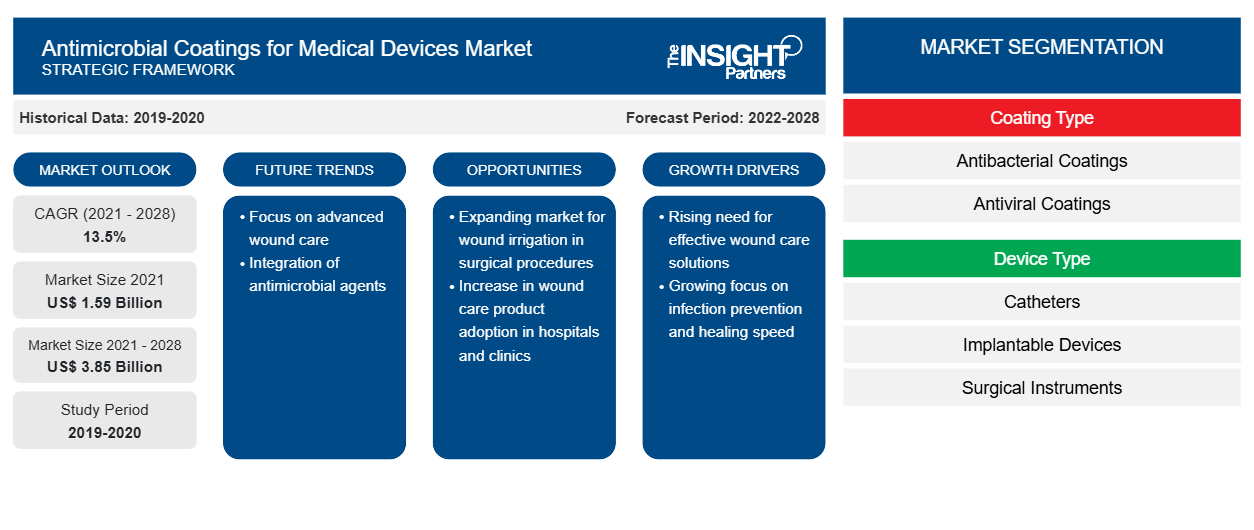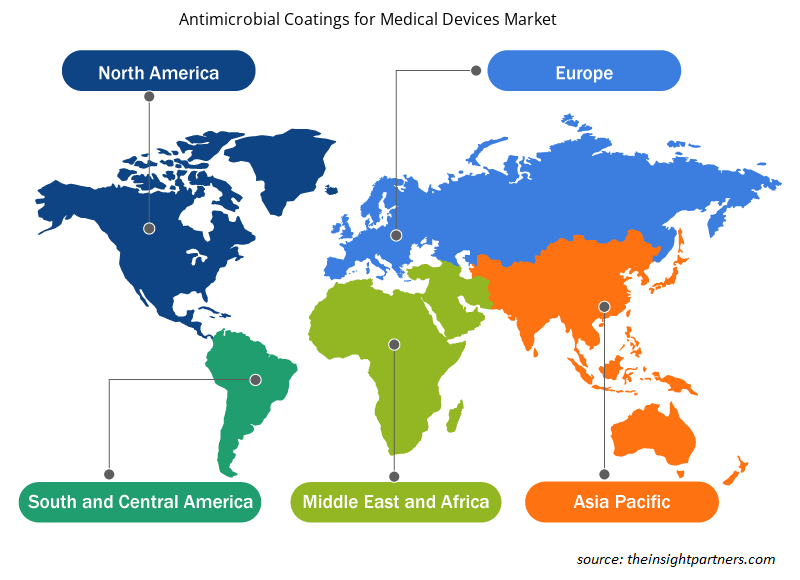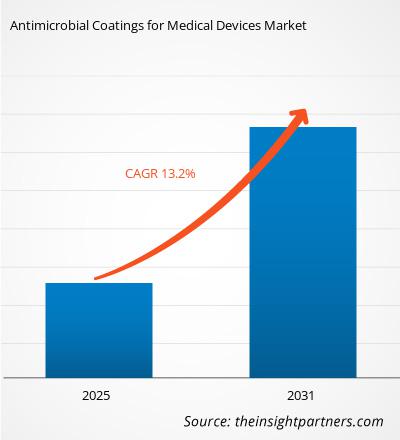Der Markt für antimikrobielle Beschichtungen für Medizinprodukte soll von 2,80 Milliarden US-Dollar im Jahr 2024 auf 6,49 Milliarden US-Dollar im Jahr 2031 anwachsen. Für den Zeitraum 2025–2031 wird eine durchschnittliche jährliche Wachstumsrate (CAGR) von 13,2 % erwartet. Die Integration von Nanotechnologie dürfte weiterhin ein wichtiger Trend im Markt für antimikrobielle Beschichtungen für Medizinprodukte bleiben.
Marktanalyse für antimikrobielle Beschichtungen für medizinische Geräte
Der Markt für antimikrobielle Beschichtungen für Medizinprodukte wird in den kommenden Jahren voraussichtlich deutlich wachsen. Grund dafür sind die steigende Prävalenz von nosokomialen Infektionen (HAI), die steigende Nachfrage nach fortschrittlicher Medizintechnik und der zunehmende Fokus auf Patientensicherheit. Wichtige Marktteilnehmer investieren in Forschung und Entwicklung, um innovative antimikrobielle Beschichtungen mit verbesserter Wirksamkeit und Haltbarkeit zu entwickeln. Geografisch gesehen werden Nordamerika und Europa den Markt voraussichtlich dominieren, da dort eine gut ausgebaute Gesundheitsinfrastruktur und strenge Vorschriften für den Einsatz antimikrobieller Beschichtungen in Medizinprodukten bestehen.
Marktübersicht für antimikrobielle Beschichtungen für medizinische Geräte
Antimikrobielle Beschichtungen werden auf medizinische Geräte wie Katheter, Implantate und chirurgische Instrumente aufgebracht, um das Wachstum schädlicher Mikroorganismen zu hemmen und das Infektionsrisiko zu verringern. Diese Beschichtungen können aus verschiedenen Materialien hergestellt werden, darunter Silber, Kupfer und quartäre Ammoniumverbindungen, die jeweils über einzigartige Eigenschaften und Wirksamkeit verfügen. Der Marktfortschritt wird durch Faktoren wie das zunehmende Bewusstsein für die Bedeutung der Infektionskontrolle, die zunehmende Verbreitung minimalinvasiver Verfahren und die wachsende Nachfrage nach fortschrittlichen medizinischen Geräten, die die Ausbreitung von Infektionskrankheiten verhindern können, vorangetrieben. In Frankreich unterstützt die Regierung die Forschung im Bereich antimikrobieller Beschichtungen finanziell stark. So erhielt SPARTHA Medical, ein französisches MedTech-Unternehmen, das multifunktionale antimikrobielle, antivirale und entzündungshemmende Beschichtungen anbietet, im Februar 2022 Zuschüsse in Höhe von 2,4 Millionen Euro (2,75 Millionen US-Dollar) sowie zusätzliche, nicht genannte Eigenkapitalfinanzierung aus dem Fonds des Europäischen Innovationsrats (EIC). Darüber hinaus gab SPARTHA Medical im Dezember 2021 den Abschluss seiner ersten Finanzierungsrunde in Höhe von 1,4 Millionen Euro (1,44 Millionen US-Dollar) für die Entwicklung maßgeschneiderter Beschichtungen bekannt. Insbesondere französische Hersteller medizinischer Geräte werden für ihren potenziellen Beitrag zur erfolgreichen Bewältigung der COVID-19-Pandemie und zur Aufrechterhaltung ihrer Import- und Exportquote während der Finanzkrise gewürdigt. Auch Deutschland verfügt über ein robustes Gesundheitssystem, das täglich Tausende von Patienten behandelt. Die deutsche Kommission betont zudem die Bedeutung von Krankenhaushygiene und Infektionskontrolle und gibt wertvolle Empfehlungen für die Entwicklung und Einführung wirksamer antimikrobieller Beschichtungen.
Passen Sie diesen Bericht Ihren Anforderungen an
Sie erhalten kostenlos Anpassungen an jedem Bericht, einschließlich Teilen dieses Berichts oder einer Analyse auf Länderebene, eines Excel-Datenpakets sowie tolle Angebote und Rabatte für Start-ups und Universitäten
Markt für antimikrobielle Beschichtungen für medizinische Geräte: Strategische Einblicke

-
Informieren Sie sich über die wichtigsten Markttrends in diesem Bericht.Dieses KOSTENLOSE Beispiel umfasst Datenanalysen, von Markttrends bis hin zu Schätzungen und Prognosen.
Markttreiber und Chancen für antimikrobielle Beschichtungen für medizinische Geräte
Steigende Prävalenz von Krankenhausinfektionen fördert Marktwachstum
Im Krankenhaus erworbene/im Gesundheitswesen erworbene Infektionen (HAI) umfassen katheterassoziierte Harnwegsinfektionen (CAUTI), zentralvenös übertragene Blutstrominfektionen und beatmungsassoziierte Pneumonie. Diese Infektionen können auch an chirurgischen Eingriffen auftreten und werden als postoperative Infektionen (SSI) bezeichnet. HAI stellen eine erhebliche wirtschaftliche Belastung für das Gesundheitssystem dar. Laut dem US-Gesundheitsministerium treiben die zunehmende Verbreitung von HAI (von denen fast jeder 31. Krankenhauspatient betroffen ist) und die zunehmende Bedeutung der Infektionskontrolle die Nachfrage nach fortschrittlichen antibakteriellen Lösungen in die Höhe. Außerdem zählen die Centers for Disease Control and Prevention (CDC) CAUTI zu den häufigsten HAI. CAUTI werden mit erhöhter Morbidität, Mortalität, höheren Gesundheitskosten und längeren Krankenhausaufenthalten in Verbindung gebracht. Laut CDC erhalten 15 bis 25 % der Krankenhauspatienten während ihres Aufenthalts Harnkatheter, die für etwa 75 % der im Krankenhaus erworbenen Harnwegsinfektionen verantwortlich sind. Der Einsatz antibakterieller Beschichtungen auf Kathetern kann dazu beitragen, das Auftreten dieser Infektionen zu reduzieren, indem sie die bakterielle Besiedlung hemmen. Das wachsende Bewusstsein für Infektionskontrolle , die steigende Zahl chirurgischer Eingriffe und die zunehmende Verbreitung chronischer Erkrankungen, die häufig eine Katheterisierung erfordern, fördern das Marktwachstum antibakterieller Beschichtungen für medizinische Geräte.HAIs) encompass catheter-associated urinary tract infections (CAUTI), central line-associated bloodstream infections, and ventilator-associated pneumonia. These infections can also arise at surgical sites, known as surgical site infections (SSIs). HAIs impose a significant economic burden on the healthcare system. According to the US Department of Health and Human Services, the increasing prevalence of HAIs (which affect nearly 1 in 31 hospitalized patients) and the growing emphasis on infection control drive the demand for advanced antibacterial solutions. Further, the Centers for Disease Control and Prevention (CDC) lists CAUTIs among the most common HAIs. CAUTIs are linked to increased morbidity, mortality, healthcare costs, and longer hospital stays. As per the CDC, 15–25% of hospitalized patients receive urinary catheters during their stay, which are associated with approximately 75% of UTIs acquired in hospitals. The use of antibacterial coatings on catheters can help reduce the incidence of these infections by inhibiting bacterial colonization. The burgeoning awareness of catheterization in patients bolster the antibacterial coatings for medical devices market growth.
Finanzierungsinitiativen öffentlicher und privater Organisationen zur Schaffung von Wachstumschancen
Im Februar 2022 erhielt Spartha Medical vom Europäischen Innovationsrat eine Förderung in Höhe von 2,75 Millionen US-Dollar. Das Unternehmen plante, diese Mittel zu nutzen, um seine antimikrobiellen, antiviralen und entzündungshemmenden Beschichtungen weiterzuentwickeln, klinische Studien zu starten, seine Infrastruktur und sein Team auszubauen sowie seine Beschichtungstechnologie weiterzuentwickeln. Anfang 2020 veröffentlichten Forscher des Zentrums für kooperative Forschung zu Biomaterialien (CIC biomaGUNE, Spanien) ein Forschungsprojekt mit dem Titel „Antibakterielle Schicht-für-Schicht-Beschichtungen für medizinische Implantate“. Die Studie zeigte die Effizienz der Schicht-für-Schicht-Technik, die vielfältige Möglichkeiten für die Anwendung antibakterieller Beschichtungen auf Implantaten bietet. Das Projekt MAT2017-88752-R Retos des spanischen Wirtschaftsministeriums finanzierte die Forschung. Diese von öffentlichen und privaten Organisationen bereitgestellten Mittel unterstützen Forschung, Entwicklung und klinische Studien im Bereich antimikrobieller Beschichtungen, was dem Markt für antimikrobielle Beschichtungen für Medizinprodukte in den kommenden Jahren voraussichtlich zugutekommen wird. Der Anstieg der Finanzierungen und Investitionen schafft auch Chancen für neue Marktteilnehmer und Akteure auf den Schwellenmärkten.
Segmentierungsanalyse des Marktberichts „Antimikrobielle Beschichtungen für medizinische Geräte“
Wichtige Segmente, die die Grundlage der Marktanalyse antimikrobieller Beschichtungen für medizinische Geräte bilden, sind Material, Beschichtungstyp, Gerätetyp, Anwendung und Endbenutzer.
- Der Markt für antimikrobielle Beschichtungen für medizinische Geräte wird nach Material in metallische und nichtmetallische Beschichtungen unterteilt. Das Segment der metallischen Beschichtungen hatte im Jahr 2024 einen größeren Marktanteil.
- Nach Beschichtungstyp ist der Markt in antibakterielle Beschichtungen, antivirale Beschichtungen und andere segmentiert. Das Segment antibakterielle Beschichtungen hielt im Jahr 2024 den größten Marktanteil bei antimikrobiellen Beschichtungen für medizinische Geräte.
- Der Markt für antimikrobielle Beschichtungen für medizinische Geräte ist nach Gerätetyp in Katheter, implantierbare Geräte, chirurgische Instrumente und weitere unterteilt. Das Segment der implantierbaren Geräte dominierte den Markt im Jahr 2024.
- Der Markt für antimikrobielle Beschichtungen für Medizinprodukte ist nach Anwendung in die Bereiche Allgemeinchirurgie, Herz-Kreislauf-Erkrankungen, Orthopädie, Gynäkologie, Zahnmedizin und weitere unterteilt. Das Herz-Kreislauf-Segment hatte im Jahr 2024 den größten Marktanteil.
- Nach Endverbraucher wird der Markt in Hersteller von Medizinprodukten, Auftragshersteller und Dienstleister unterteilt. Das Segment der Hersteller von Medizinprodukten hielt im Jahr 2024 den größten Marktanteil bei antimikrobiellen Beschichtungen für Medizinprodukte.
Marktanteilsanalyse für antimikrobielle Beschichtungen für medizinische Geräte nach geografischen Gesichtspunkten
Der geografische Umfang des Marktberichts über antimikrobielle Beschichtungen für medizinische Geräte ist in fünf Regionen unterteilt: Nordamerika, Asien-Pazifik, Europa, Naher Osten und Afrika sowie Süd- und Mittelamerika.
Nordamerika hielt 2024 einen bedeutenden Marktanteil. Die steigende Prävalenz von HAIs unterstreicht die Notwendigkeit der Entwicklung von Medizinprodukten mit antimikrobiellen Beschichtungen in dieser Region. HAIs können in allen Bereichen des Gesundheitswesens auftreten, darunter in ambulanten Operationszentren, Dialyseeinrichtungen, Akutkrankenhäusern, der ambulanten Versorgung (z. B. Arztpraxen und Kliniken) sowie in Langzeitpflegeeinrichtungen (z. B. Pflegeheimen und Reha-Einrichtungen). Laut dem US-Gesundheitsministerium ist in den USA jeder 25. Krankenhauspatient zu irgendeinem Zeitpunkt von HAI betroffen. Allein in amerikanischen Krankenhäusern sind HAIs nach Schätzungen der CDC jährlich für schätzungsweise 1,7 Millionen Infektionen und 99.000 damit verbundene Todesfälle verantwortlich, was auf Wachstumsaussichten für den Markt für antimikrobielle Beschichtungen für Medizinprodukte hindeutet.
Regionale Einblicke in den Markt für antimikrobielle Beschichtungen für medizinische Geräte
Die Analysten von Insight Partners haben die regionalen Trends und Faktoren, die den Markt für antimikrobielle Beschichtungen für Medizinprodukte im Prognosezeitraum beeinflussen, ausführlich erläutert. Dieser Abschnitt behandelt außerdem die Marktsegmente und die geografische Lage für antimikrobielle Beschichtungen für Medizinprodukte in Nordamerika, Europa, Asien-Pazifik, dem Nahen Osten und Afrika sowie Süd- und Mittelamerika.

- Erhalten Sie regionale Daten zum Markt für antimikrobielle Beschichtungen für medizinische Geräte
Umfang des Marktberichts „Antimikrobielle Beschichtungen für medizinische Geräte“
| Berichtsattribut | Details |
|---|---|
| Marktgröße im Jahr 2024 | 2,80 Milliarden US-Dollar |
| Marktgröße bis 2031 | 6,49 Milliarden US-Dollar |
| Globale CAGR (2025 – 2031) | 13,2 % |
| Historische Daten | 2021-2023 |
| Prognosezeitraum | 2025–2031 |
| Abgedeckte Segmente |
Nach Material
|
| Abgedeckte Regionen und Länder |
Nordamerika
|
| Marktführer und wichtige Unternehmensprofile |
|
Marktteilnehmerdichte für antimikrobielle Beschichtungen für medizinische Geräte: Auswirkungen auf die Geschäftsdynamik
Der Markt für antimikrobielle Beschichtungen für Medizinprodukte wächst rasant. Die steigende Nachfrage der Endverbraucher ist auf Faktoren wie veränderte Verbraucherpräferenzen, technologische Fortschritte und ein stärkeres Bewusstsein für die Produktvorteile zurückzuführen. Mit der steigenden Nachfrage erweitern Unternehmen ihr Angebot, entwickeln Innovationen, um den Bedürfnissen der Verbraucher gerecht zu werden, und nutzen neue Trends, was das Marktwachstum weiter ankurbelt.
Die Marktteilnehmerdichte beschreibt die Verteilung der in einem bestimmten Markt oder einer bestimmten Branche tätigen Unternehmen. Sie gibt an, wie viele Wettbewerber (Marktteilnehmer) in einem bestimmten Marktraum im Verhältnis zu dessen Größe oder Gesamtmarktwert präsent sind.
Die wichtigsten Unternehmen auf dem Markt für antimikrobielle Beschichtungen für medizinische Geräte sind:
- Die Sherwin-Williams Co
- PPG Industries Inc.
- CytaCoat AB
- Covalon Technologies Ltd
- Koninklijke DSM NV
- Spezialbeschichtungssysteme Inc.
Haftungsausschluss : Die oben aufgeführten Unternehmen sind nicht in einer bestimmten Reihenfolge aufgeführt.

- Erhalten Sie einen Überblick über die wichtigsten Akteure auf dem Markt für antimikrobielle Beschichtungen für medizinische Geräte
Marktnachrichten und aktuelle Entwicklungen zu antimikrobiellen Beschichtungen für medizinische Geräte
Der Markt für antimikrobielle Beschichtungen für Medizinprodukte wird durch die Erhebung qualitativer und quantitativer Daten aus Primär- und Sekundärforschung bewertet, die wichtige Unternehmenspublikationen, Verbandsdaten und Datenbanken einbeziehen. Nachfolgend sind einige der Marktentwicklungen aufgeführt:
- Hydromer, Inc., Hersteller hydrophiler, thromboresistenter und antimikrobieller Beschichtungstechnologien für medizinische Geräte, hat HydroThrombX auf den Markt gebracht, eine Weiterentwicklung des bestehenden Produkts F200t. F200t ist eine thromboresistente Beschichtung, die dafür bekannt ist, die Thrombozytenadhäsion und Zellmitose deutlich zu reduzieren und so zur Vorbeugung von Restenosen beizutragen. (Quelle: Hydromer, Inc., Pressemitteilung, Juni 2024)
- Biointeraction hat die Markteinführung seiner antimikrobiellen Beschichtung TriDant bekannt gegeben. TridAnt umfasst aktive und passive Komponenten. Laut BioInteractions handelt es sich bei dem neuen Produkt um eine nicht auslaugende Beschichtung, die Oberflächen infektionsresistent macht und das Risiko der Biofilmbildung reduziert – und das ganz ohne toxische oder eluierende Komponenten. Die Beschichtung wirkt gegen ein breites Spektrum an Bakterien und reduziert so das Infektionsrisiko deutlich. BioInteractions vermarktet TridAnt zur Anwendung auf Venen- und Urinkathetern, Kontaktlinsen, Titan-Kranioplastik, Wundverbänden, Etiketten und Schutzanstrichen für Schiffe. (Quelle: BioInteractions Ltd, Pressemitteilung, April 2022)
Marktbericht zu antimikrobiellen Beschichtungen für medizinische Geräte – Umfang und Ergebnisse
Der Bericht „Marktgröße und Prognose für antimikrobielle Beschichtungen für medizinische Geräte (2021–2031)“ bietet eine detaillierte Analyse des Marktes, die die folgenden Bereiche abdeckt:
- Marktgröße und Prognose für antimikrobielle Beschichtungen für medizinische Geräte auf globaler, regionaler und Länderebene für alle wichtigen Marktsegmente, die im Rahmen des Geltungsbereichs abgedeckt sind
- Markttrends und Marktdynamiken für antimikrobielle Beschichtungen für medizinische Geräte wie Treiber, Einschränkungen und wichtige Chancen
- Detaillierte PEST- und SWOT-Analyse
- Marktanalyse für antimikrobielle Beschichtungen für medizinische Geräte mit Blick auf wichtige Markttrends, globale und regionale Rahmenbedingungen, wichtige Akteure, Vorschriften und aktuelle Marktentwicklungen
- Branchenlandschaft und Wettbewerbsanalyse mit Marktkonzentration, Heatmap-Analyse, prominenten Akteuren und jüngsten Entwicklungen auf dem Markt für antimikrobielle Beschichtungen für medizinische Geräte
- Detaillierte Firmenprofile
- Historische Analyse (2 Jahre), Basisjahr, Prognose (7 Jahre) mit CAGR
- PEST- und SWOT-Analyse
- Marktgröße Wert/Volumen – Global, Regional, Land
- Branchen- und Wettbewerbslandschaft
- Excel-Datensatz
Aktuelle Berichte
Verwandte Berichte
Erfahrungsberichte
Grund zum Kauf
- Fundierte Entscheidungsfindung
- Marktdynamik verstehen
- Wettbewerbsanalyse
- Kundeneinblicke
- Marktprognosen
- Risikominimierung
- Strategische Planung
- Investitionsbegründung
- Identifizierung neuer Märkte
- Verbesserung von Marketingstrategien
- Steigerung der Betriebseffizienz
- Anpassung an regulatorische Trends






















 Kostenlose Probe anfordern für - Markt für antimikrobielle Beschichtungen für medizinische Geräte
Kostenlose Probe anfordern für - Markt für antimikrobielle Beschichtungen für medizinische Geräte